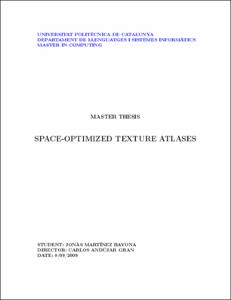Mostra el registre d'ítem simple
Space-optimized texture atlases
| dc.contributor | Andújar Gran, Carlos Antonio |
| dc.contributor.author | Martínez Bayona, Jonàs |
| dc.contributor.other | Universitat Politècnica de Catalunya. Departament de Llenguatges i Sistemes Informàtics |
| dc.date.accessioned | 2009-11-05T11:45:07Z |
| dc.date.available | 2009-11-05T11:45:07Z |
| dc.date.issued | 2009-09-08 |
| dc.identifier.uri | http://hdl.handle.net/2099.1/7720 |
| dc.description.abstract | Texture atlas parameterization provides an effective way to map a variety of colour and data attributes from 2D texture domains onto polygonal surface meshes. Most of the existing literature focus on how to build seamless texture atlases for continuous photometric detail, but little e ort has been devoted to devise e cient techniques for encoding self-repeating, uncontinuous signals such as building facades. We present a perception-based scheme for generating space-optimized texture atlases speci cally designed for intentionally non-bijective parameterizations. Our scheme combines within-chart tiling support with intelligent packing and perceptual measures for assigning texture space in accordance to the amount of information contents of the image and on its saliency. We demonstrate our optimization scheme in the context of real-time navigation through a gigatexel urban model of an European city. Our scheme achieves signi cant compression ratios and speed-up factors with visually indistinguishable results. We developed a technique that generates space-optimized texture atlases for the particular encoding of uncontinuous signals projected onto geometry. The scene is partitioned using a texture atlas tree that contains for each node a texture atlas. The leaf nodes of the tree contain scene geometry. The level of detail is controlled by traversing the tree and selecting the appropriate texture atlas for a given viewer position and orientation. In a preprocessing step, textures associated to each texture atlas node of the tree are packed. Textures are resized according to a given user-de ned texel size and the size of the geometry that are projected onto. We also use perceptual measures to assign texture space in accordance to image detail. We also explore different techniques for supporting texture wrapping of uncontinuous signals, which involved the development of e cient techniques for compressing texture coordinates via the GPU. Our approach supports texture ltering and DXTC compression without noticeable artifacts. We have implemented a prototype version of our space-optimized texture atlases technique and used it to render the 3D city model of Barcelona achieving interactive rendering frame rates. The whole model was composed by more than three million triangles and contained more than twenty thousand different textures representing the building facades with an average original resolution of 512 pixels per texture. Our scheme achieves up 100:1 compression ratios and speed-up factors of 20 with visually indistinguishable results. |
| dc.language.iso | eng |
| dc.publisher | Universitat Politècnica de Catalunya |
| dc.rights | Attribution-NonCommercial-NoDerivs 3.0 Spain |
| dc.rights.uri | http://creativecommons.org/licenses/by-nc-nd/3.0/es/ |
| dc.subject | Àrees temàtiques de la UPC::So, imatge i multimèdia::Creació multimèdia::Imatge digital |
| dc.subject.lcsh | Image processing -- Digital techniques |
| dc.title | Space-optimized texture atlases |
| dc.type | Master thesis |
| dc.subject.lemac | Imatges -- Processament -- Tècniques digitals |
| dc.rights.access | Open Access |
| dc.audience.educationlevel | Màster |
| dc.audience.mediator | Facultat d'Informàtica de Barcelona |
| dc.audience.degree | MÀSTER UNIVERSITARI EN COMPUTACIÓ (Pla 2006) |


